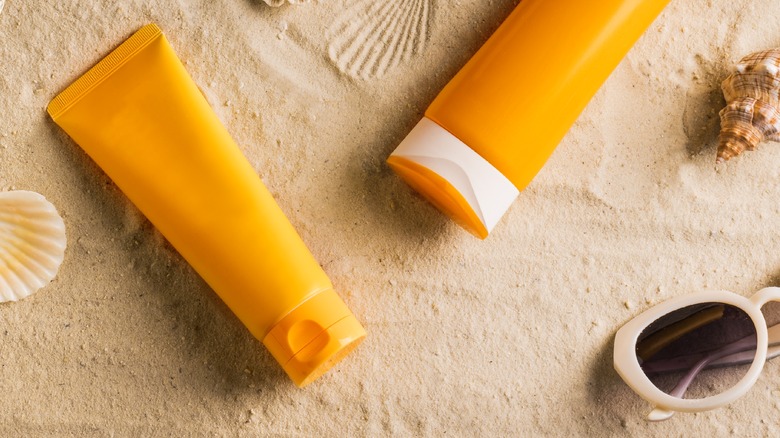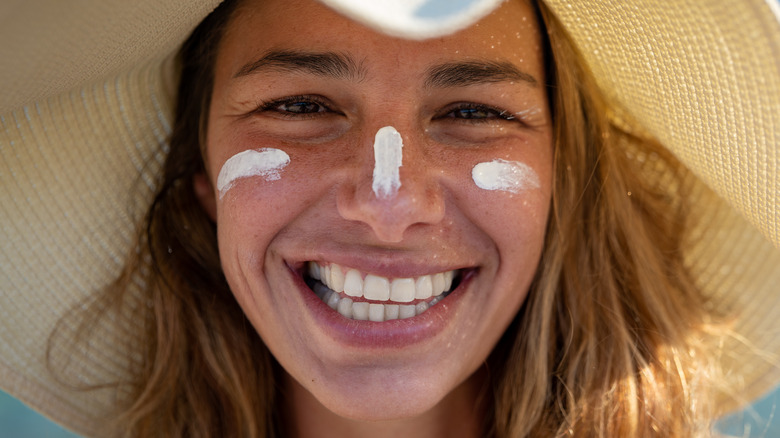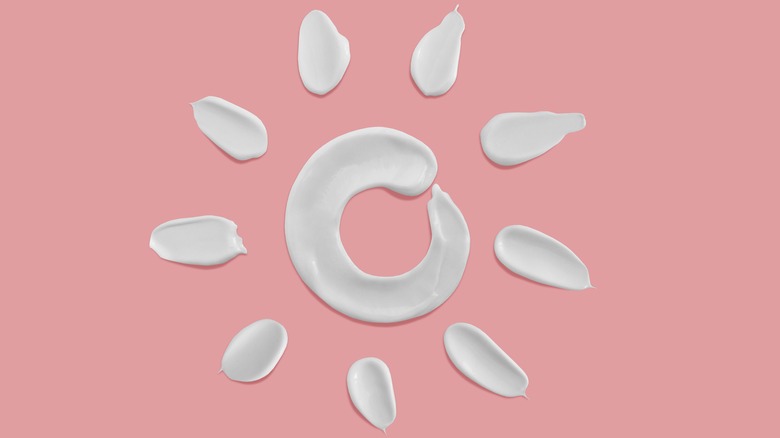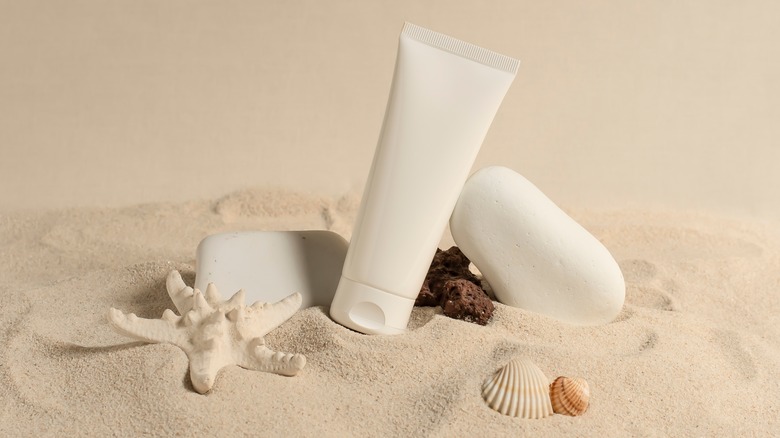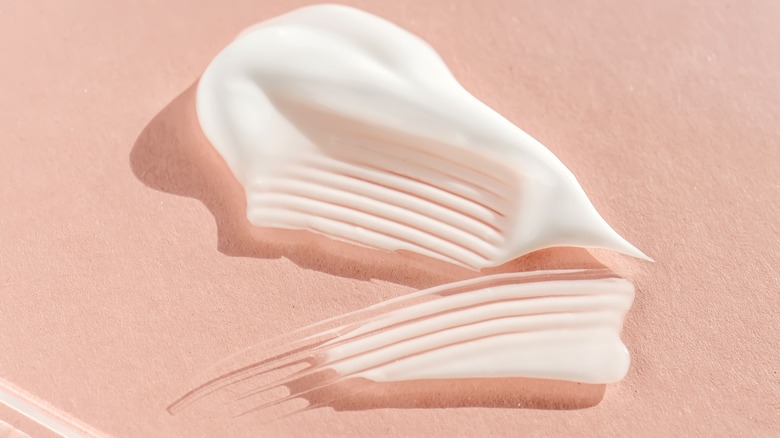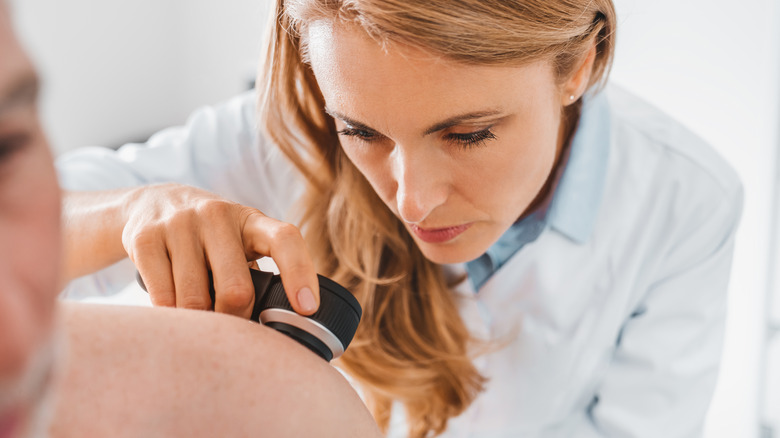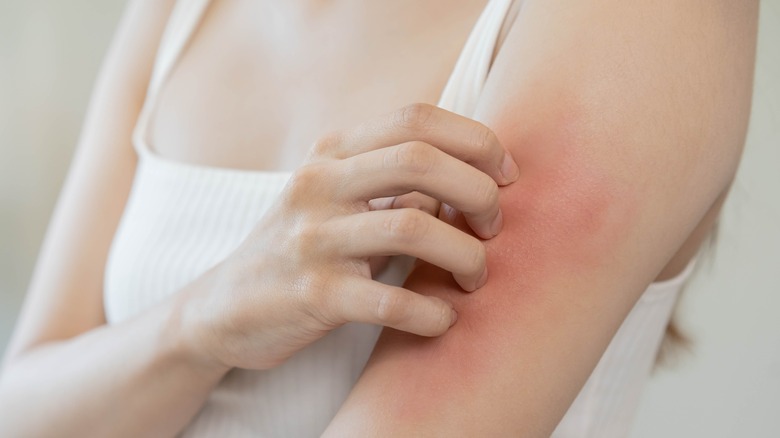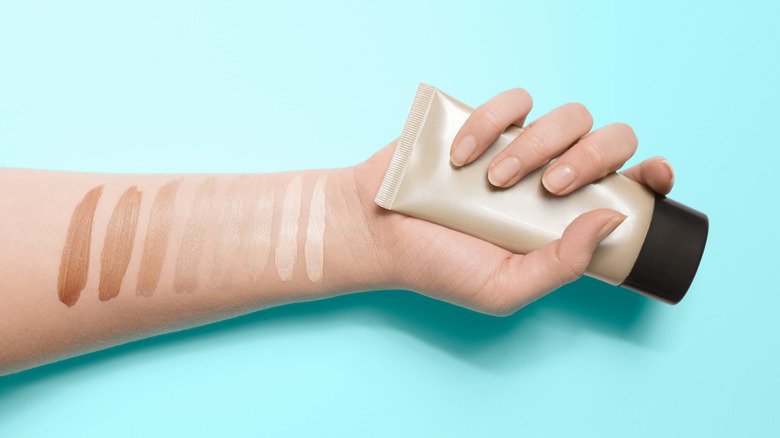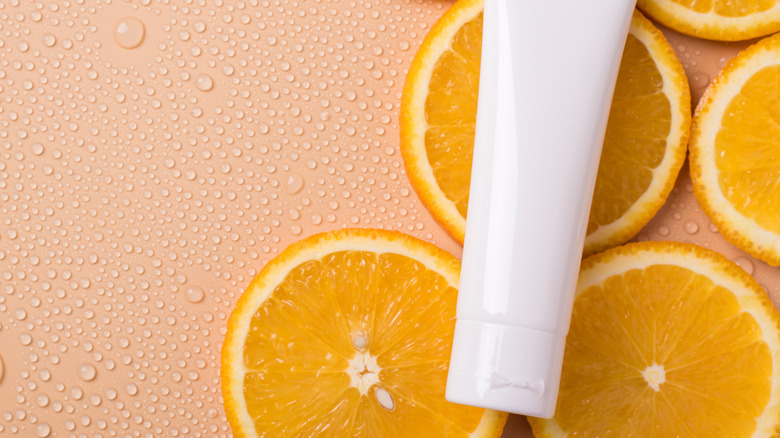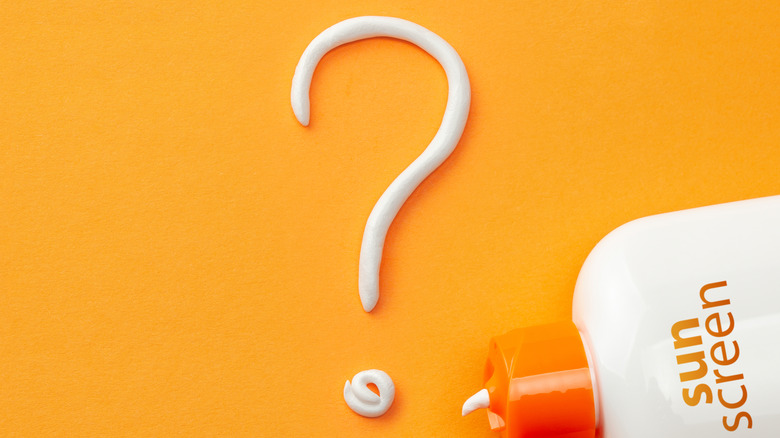Your Guide To Decoding SPF Terms
Have you ever visited the sunscreen aisle at your local drugstore only to stare blankly at the shelves filled with what seems like endless brands and variations of sunscreen? If so, you're not alone. You might think that sunscreen is somewhat of a one-size-fits-all product, when in reality, there are numerous types of sunscreen made for different uses, skin types, and sun sensitivity needs.
Don't worry — we're going to break all that down for you in a moment so that you can understand exactly what you're buying and what to look for in sunscreen. But first, let's start with the basics: SPF. SPF stands for sun protection factor, and it's the most important sunscreen feature to understand. Generally, the higher the SPF number, the more sun protection that sunscreen offers. Of course, how well you apply sunscreen and how frequently you apply it also affect whether you walk off the beach unscathed from the hot sun, so SPF isn't the only thing to consider (per the FDA). This guide dives into other common terms relating to sunscreen that you should know before you buy.
The differences between UV, UVA, and UVB
Perhaps the next most important terms to understand are UV, UVA, and UVB. Some sunscreens claim to protect against UV rays, while others add that they prevent harmful UVA and UVB rays from wreaking havoc on your skin. What's the difference between it all?
UV is the abbreviation for ultraviolet. Ultraviolet rays are the natural rays produced by the sun that we feel when our skin warms on a sunny day (per the Skin Cancer Foundation). Ultraviolet A (UVA) and ultraviolet B (UVB) are the two different types of ultraviolet radiation the sun produces. Both can be potentially dangerous for skin, as UVB radiation causes sunburn, while UVB radiation can lead to long-term skin damage and premature aging. Additionally, any form of UV radiation can lead to skin cancer.
So, sunscreen that offers UV protection could technically protect against UVA, UVB, or both types of UV radiation. Sunscreen that only mentions one or the other may not offer the comprehensive protection you want from your sunscreen.
Broad spectrum
We know that radiation from the sun is something we should try our best to avoid, and wearing sunscreen every time we're outdoors is one of the best ways to do that. What many people might not know is that sunscreen labeled as broad-spectrum is likely your best defense against the sun's rays.
Broad-spectrum sunscreen protects against both UVA and UVB rays. Applying it to your skin means you're being proactive against sunburns, skin damage and aging, and of course, the potential cancer-causing effects of the sun. The FDA requires sunscreens labeled as broad-spectrum to meet specific guidelines first (per the Skin Cancer Foundation).
Additionally, the FDA says that sunscreens not meeting these standards must add an extra warning to their packaging indicating that they don't protect against skin aging and cancer. Be sure to read packaging and labels carefully to get peace of mind that your broad-spectrum choice is, indeed, giving you the protection you expect.
Active and inactive ingredients
Turn a bottle of sunscreen around, and you'll see its label listing ingredients and directions for usage. You might also notice that there are two types of ingredients listed — active and inactive — which can get a bit confusing.
Although an inactive ingredient sounds like it doesn't do much work, it's an important part of the formula of a product. Inactive ingredients are anything other than the active ingredient (per the FDA). However, they're there for a reason. In sunscreen, inactive ingredients help hold the active ingredients together to allow them to work properly (via PBS). You'll see ingredients like oil, water, or preservatives listed as inactive ingredients, for example. You might also see coloring or fragrance, depending on the type of sunscreen.
PBS explains that active ingredients in sunscreen are those that actually provide sun protection, like zinc oxide and avobenzone. Some sunscreens offer just one active ingredient, while others have two or more. Fortunately, there are plenty of effective active ingredients in different sunscreen brands, so if you have allergies or sensitivities to a specific ingredient, you should still be able to find sunscreen that works for you.
Waterproof versus water-resistant
Don't feel bad if you've ever been fooled into purchasing waterproof sunscreen. Some sunscreen brands may allude to their formulas being waterproof in their marketing campaigns, allowing for all-day coverage even when you're in and out of the water. However, there's no way for sunscreen to be 100% waterproof, according to the Skin Cancer Foundation, which is why the FDA no longer allows brands to place the phrase on their sunscreen packaging.
What they can do is use the term "water-resistant," which simply means that the formula may last longer on your skin if you take a dip in the water. Along the same lines, sweat-resistant is sometimes used by sunscreen brands to indicate that your sunscreen could withstand sweat better than others.
Regardless of how sweat-resistant or water-resistant your sunscreen claims to be, it's still crucial to stick to the general rule of applying sunscreen at least once every two hours while you're outdoors for maximum protection against the sun's rays (per the American Academy of Dermatology Association).
Mineral, physical, organic, or chemical?
The terms mineral, physical, organic, and chemical are often placed on sunscreen bottles, with mineral and organic the most popular of the bunch. This becomes less confusing when you know that mineral and physical can be used interchangeably, while organic and chemical are synonyms for each other.
Mineral or physical sunscreen is made with mineral active ingredients, like zinc oxide, that help protect the skin from both UVA and UVB rays (per the University of Texas-Austin). In contrast, organic or chemical sunscreens have a chemical-based active ingredient, like avobenzone, that absorb and counteract UV rays.
Neither one is necessarily clearly better, but one may fit your skin type and personal preferences better. Dermatologist Deborah Spey explains to NBC News that dermatologists may recommend mineral sunscreens because their natural ingredients are inherently broad-spectrum, while an organic sunscreen may not have the same broad-spectrum properties. However, the University of Texas-Austin says that organic sunscreens may last longer on the skin because of their lotion-like texture. Just be sure to avoid any sunscreen with ingredients you're allergic or sensitive to.
Dermatologist tested, dermatologist approved, or clinically proven
Phrases like "dermatologist tested" and "clinically proven" are used so frequently nowadays that they can almost feel like buzzwords. And in some cases, they might be.
Dermatologist Jessica Weiser tells PopSugar that there are currently no legal standards that brands using "dermatologist tested" or "dermatologist approved" must meet before they can go on a bottle of skincare products like sunscreen. Rather, a brand might partner with a dermatologist or offer a financial incentive to back it. GoodRx Health adds that while the term "clinically proven" may sound sophisticated and trustworthy, it has no technical grounds to stand on.
In other words, none of these terms mean that a product is FDA-approved or necessarily better than any of its competitors. Instead, they're typically used to help market a product or show that a dermatologist has, indeed, tested or given a thumbs-up to a product using their medical knowledge, says Weiser. However, the best way to know what's best for your skin is probably to ask your own dermatologist for recommendations based on your specific skincare needs.
Hypoallergenic and non-comedogenic
Sunscreen designed for sensitive skin types is usually labeled as hypoallergenic, non-comedogenic, or both. That's because both terms indicate that a sunscreen formula may prevent typical skin problems people with sensitive skin have, like breakouts or clogged pores.
Cetaphil explains that non-comedogenic skincare products are made to reduce the likelihood of clogged pores, which may result in breakouts, blackheads, or whiteheads. Although non-comedogenic sunscreen isn't guaranteed to prevent these common skin problems, they could be helpful for people who have naturally oily skin.
Sunscreen labeled as hypoallergenic typically has a lower risk of causing allergic or sensitive reactions on sensitive skin than non-hypoallergenic variations. However, the FDA explains that there are no specific legal requirements for a product to be labeled as hypoallergenic. Additionally, a hypoallergenic label isn't a guarantee that a product won't cause a reaction on your skin. Therefore, it's best to do your due diligence in researching sunscreen ingredients before buying a bottle.
Tinted
Perhaps one of the newest terms to hit the sunscreen industry is "tinted," which applies to sunscreen with additional, subtle color that helps block dangerous UV rays. According to Optum, sunscreen manufacturers make tinted sunscreen by mixing oxides in shades of yellow, red, and black to create colors that mimic skin tones.
When applied, a tinted sunscreen can give your skin a healthy-looking glow without looking overpowering like tanning lotion sometimes can. Thus, it has the added perk of reflecting sunlight to keep your skin protected and reduce the effects the sun has on aging.
Allure notes that there are several types of tinted sunscreens to choose from, including coverage variations for everything from a subtle tint to a more intense glow. In addition to sunscreen lotion, tinted sunscreen is also available as a liquid or powder, giving you choices when it comes to finding a formula that feels best on your skin.
Paraben-free
Parabens are commonly found in cosmetics and skin care products, like sunscreen. However, you may have seen a recent uptick in the phrase "paraben-free" on the labels of the products you use. As more research is being done on parabens — which the Environmental Working Group (EWG) explains are chemicals typically used to preserve these products — the more we learn about their potentially harmful effects on the body. The EWG states that not only can they cause skin irritation, but parabens may also interfere with natural hormone processes, potentially affecting reproduction and fertility.
In some countries, parabens are banned completely from products. However, the FDA still approves them for use in U.S. products (per PerkinElmer). Therefore, some brands have chosen to create products without the use of parabens on their own, labeling them as "paraben-free" to let customers know their products do not contain these preservatives. Still, it's a good idea to check out the ingredients to make sure a product is genuinely free from parabens. According to the EWG, the most common parabens to look for include ethylparaben, butylparaben, isopropylparaben, isobutylparaben, methylparaben, and propylparaben.
Safe for baby skin
Often, sunscreen brands usually have one or two sunscreen products labeled as safe for baby skin. By nature, baby skin is typically more sensitive than that of a toddler, child, adolescent, or adult. As their skin matures, it's important to keep it hydrated, clean, and moisturized. And although avoiding sunlight is usually the best protection for fragile baby skin, a safe-for-baby sunscreen should be your second line of defense (per Johns Hopkins Medicine).
While any sunscreen bottle might be labeled as baby-safe, the American Academy of Dermatology Association recommends looking for either zinc oxide or titanium dioxide as the active ingredient in a sunscreen you buy for your baby, as these natural ingredients are usually less irritating for sensitive baby skin. And, even if you slather your baby in sunscreen when outdoors, don't forget to keep their skin covered as much as possible with a hat, long sleeves, and plenty of shade.
Sand-resistant sunscreen
One of the most common places to wear sunscreen is, of course, on a sandy beach on a hot summer's day. Unfortunately, sunscreen and sand don't seem to mix well. Sand sticks to sunscreen as soon as it's applied, and the abrasive nature of sand could slough off your sunscreen just as quickly as you put it on. Sand might also reduce the power of your sunscreen's SPF, making its skin protection less effective.
Enter sand-resistant sunscreen, which is designed to withstand the power of sand to keep your sunscreen working its best (via the Journal of Cosmetic Science). However, like other phrases that can be added to bottles of sunscreen, there's currently no set definition for "sand-resistant" approved by the FDA. Some sunscreens using the term claim that their formulas can help prevent sand from sticking to the skin, but there's no foolproof way to ensure that stand stays away. Instead, be diligent about reapplying sunscreen frequently when you're enjoying a day on the beach.
Antioxidants
Antioxidants can help prevent cell damage. As we know, the sun's rays can damage skin cells if we don't keep our skin protected by sunscreen and layers of clothing. Antioxidants naturally occur in a lot of food we eat, especially fruits and vegetables, but product manufacturers often add antioxidants to lotions and cosmetics to enhance their skin-boosting, anti-aging properties (via the National Center for Complementary and Integrative Health).
In sunscreen, antioxidants can add one more layer of protection to your skin. Board-certified dermatologist Olasz Harken tells Froedtert & Medical College of Washington that "sunscreen is the No. 1 anti-aging cream to use each day," and that the addition of antioxidants can be exceptionally beneficial in slowing skin aging and preventing cell damage. Harken mentions that a common antioxidant in sunscreen is vitamin C, a water-soluble vitamin that's packed into tomatoes, bell peppers, and citrus fruits (per the Harvard T.H. Chan School of Public Health).
Potentially troublesome SPF-related words to watch for
Even sunscreen bottles labeled as "all-natural" or "safe for sensitive skin" might include an alarming number of ingredients. That's why it's crucial to have a basic understanding of what should and shouldn't be in your sunscreen.
The current proposed rule by the FDA recognizes only two active ingredients — zinc oxide and titanium dioxide — as generally safe and effective to use in sunscreen. Others, like dioxybenzone, oxybenzone, and avobenzone, are not recognized in the same way by the FDA due to a lack of data to support their safety. According to the EWG, these and other common sunscreen ingredients, like octinoxate and homosalate, absorb into the body quickly and may remain in the blood for weeks after using sunscreen containing them. Additionally, some research suggests that oxybenzone, specifically, may cause skin allergies and could be harmful to the environment (via the American Cancer Society).
If you're ever in doubt about what's in your sunscreen and whether it's safe to use, ask your doctor or dermatologist.

